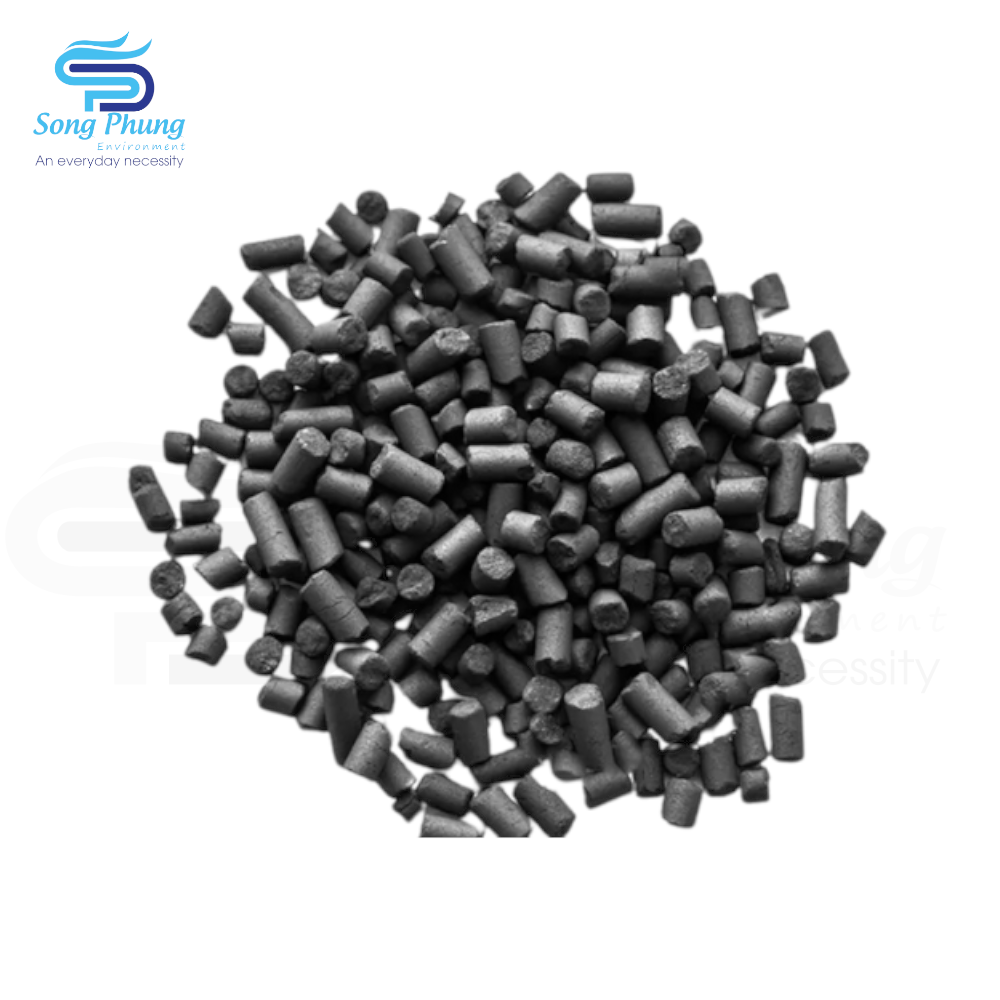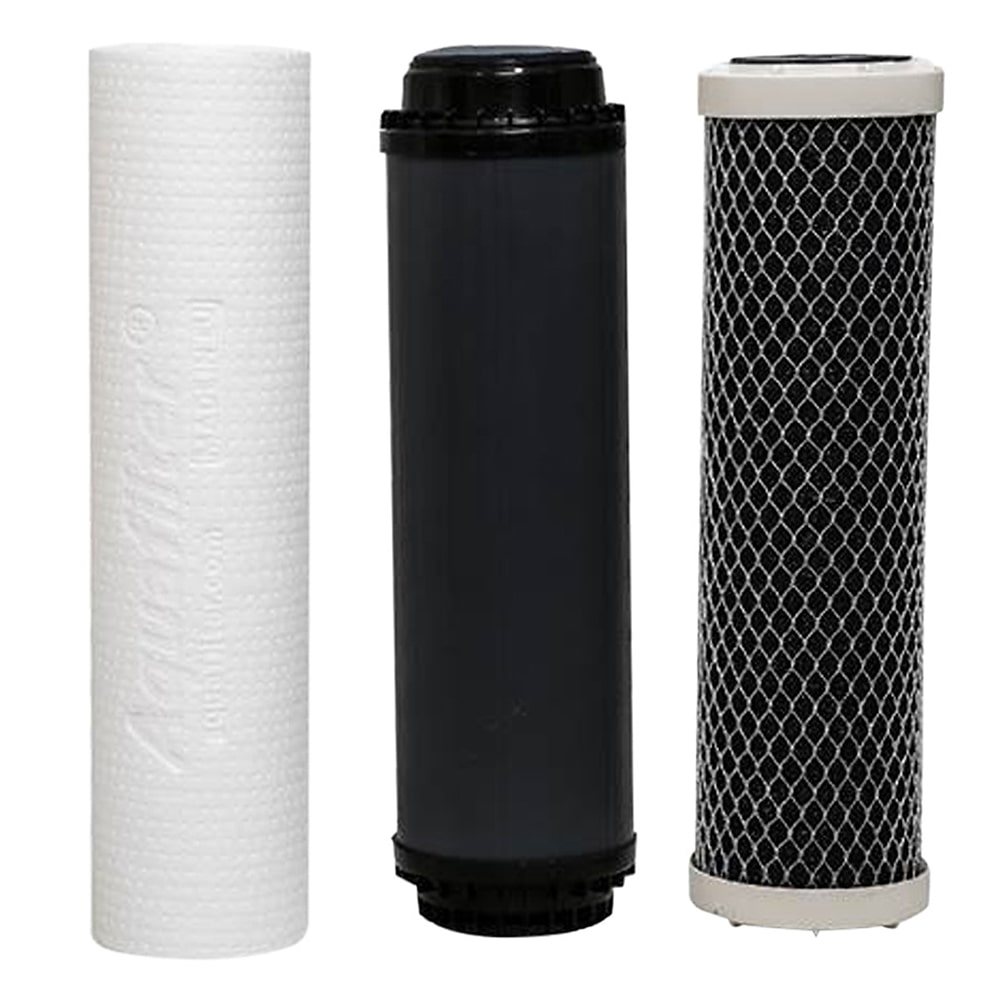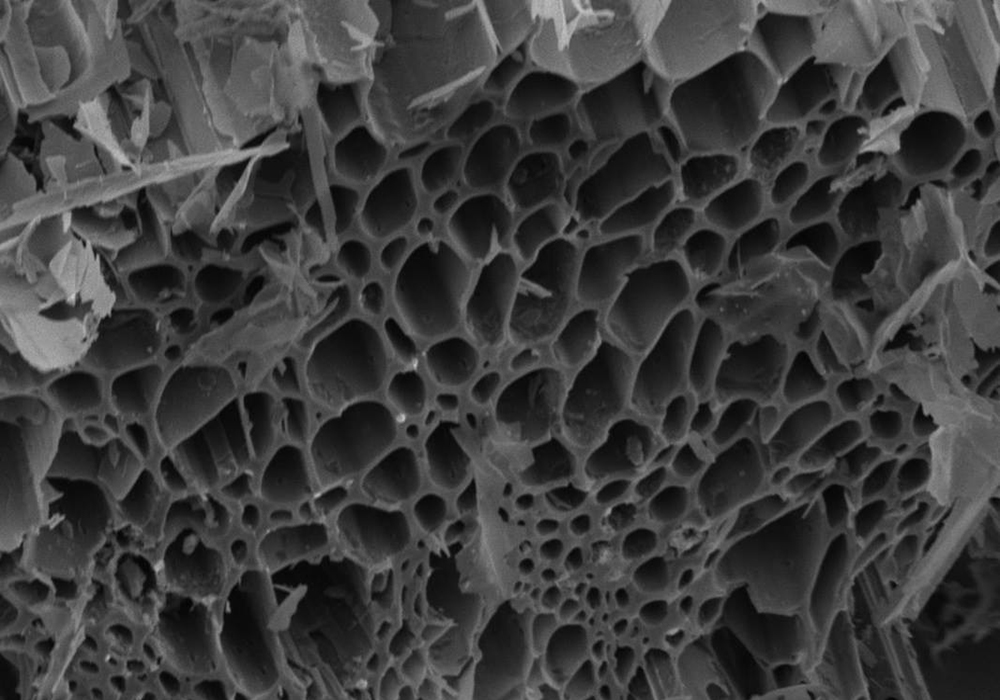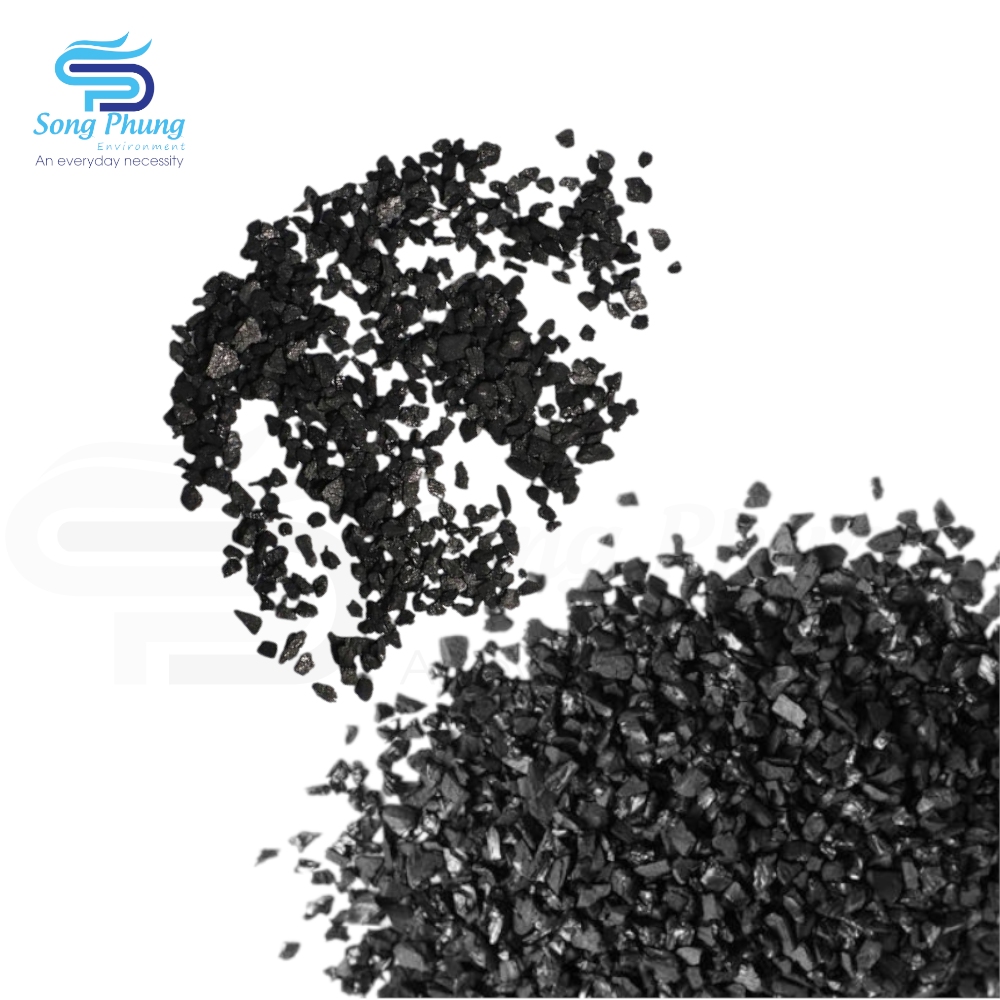Activated carbon is one of the commonly used materials in water purification systems and applications. They are a form of carbon with porosity, many cracks, pores small to the molecular size. Typically, activated carbon is used to remove organic compounds or extract free chlorine from water. In addition, you can refer to some more ways to distinguish activated carbon water filter from regular charcoal in the article below!
What is activated carbon?
Activated carbon water filter (activated carbon) is a form of carbon with high porosity, many cracks, small pores to molecular size. Thanks to this special structure, the surface area of activated carbon is very large, making it easy to absorb and react with many different substances. Activated carbon for water purification is made from carbon-rich fuels such as coconut shells, coal, wood, and bamboo at high temperatures from 600 to 900oC under anaerobic conditions.
The effect of activated carbon in water purification
Activated carbon filter water is often used to remove organic compounds (fulvic acid, humic acid, …) or extract free chlorine from water. From there, the water can be discharged or used in water purification processes for production.
The process of water purification with activated carbon (AC: Activated Carbon), like any water treatment method, cannot completely remove contaminants such as sodium, bacteria, fluoride, nitrate, etc.
Activated carbon is often used to filter organic compounds or extract free chlorine from water
How does activated carbon filter water work?
Activated carbon filters contain small pieces of carbon (granular or bulk), which are processed to become porous with large porosity. Just 4 grams of activated carbon with a surface area equivalent to a football field (6400 square meters) will effectively absorb pollutants.
When the water flows through the activated carbon filter, the impurities will stick to the carbon making the outlet water purer. The effectiveness of absorbing dirt depends on the flow and temperature of the water. Therefore, smaller sized activated carbon filters should be used with low pressure and cold water conditions.
Activated carbon filters made from coconut shells can remove pollutants of various sizes. In addition, activated carbon can also be made of wood or coal and sold as granules or blocks.
Granular activated carbon (GAC) has no limit on the filter pore size because it is made of porous. Besides, the filter pore size of the block activated carbon is usually from 0.5 to 10 micrometers. However, if activated carbon has a too small filter pore size, it will reduce the water flow. So, the common bulk activated carbon will be 1 to 5 microns in size.
What substances can activated carbon water filters remove or reduce?
Activated carbon is effective in removing many contaminants and chemicals from tap water. However, studies cited by EPA and NSF claim the water purification efficiency of activated carbon is only 60-80% for chemicals, about 30% reduction for other substances. The water filtration efficiency of activated carbon depends on the quality and type of material used. According to the EPA (U.S. Environmental Protection Agency), activated carbon is the only filtration technology recommended to remove:
- 32 Identified organic pollutants include THMs (chlorine by-products).
- The 14 pesticides listed include: nitrate, glyphosate,…
- 12 Most common herbicides.

Here are some of the contaminants and chemicals that activated carbon can remove.
Chlorine (Cl)
Most tap water in Vietnam is inspected, tested and certified for daily use. However, chlorine is added to disinfect the water. Therefore, you should use an activated carbon filter to remove chlorine. A good quality activated carbon filter can remove 95% or more of the chlorine in the water.
Biological products from chlorine
Biological chlorine products such as THMs have been identified as potentially carcinogenic. Therefore, you should use activated carbon to filter water to remove this substance. According to the EPA, activated carbon can remove 32 biological products from chlorine.
Chloride (Cl–)
This is a natural mineral that helps maintain proper blood volume, blood pressure, and the pH of fluids in the body. However, too much chloride in the water can cause a salty taste. Chloride is a natural component of tap water and does not have any negative health effects. The effectiveness of activated carbon for water purification with chloride is very low.
The effectiveness of activated carbon for water purification with chloride is very low
Pesticides
Pesticides are products used to control plant pests, treat weeds in groundwater, lakes, rivers, and sometimes tap water. Activated carbon water filter is tested to remove the most common pesticides including: chlordane, chlordecone (CLD/Kepone), glyphosate (Round-up), heptachlor, lindane, nitrate.
Herbicide
Herbicides are chemicals that are used to prevent weeds from growing in places where people don’t want them. Activated carbon water filter has been tested to remove the most common herbicides including: 2,4-D, atrazine, etc.

Nitrates (NO3–)
Nitrates are one of the most important compounds for plants. This compound is not harmful to adults, unless used in large amounts. Nitrates in tap water are mainly derived from fertilizers, septic systems, storage operations, and manure spreading. Activated carbon filters can reduce nitrates by 50 to 70%, depending on the quality of the product.
PFOS
It is a synthetic chemical used in fire-fighting foams, metal plating and stain-repelling agents. According to a 2002 study by the OECD Environment Directorate, PFOS is a persistent, bioaccumulative and harmful substance to mammals. Using an activated carbon filter will effectively remove PFOS including: PFAS, PFOA and PFNA.
Phosphate (PO43-)
Phosphate is a strong corrosion inhibitor. High phosphate concentrations have not shown any risk to human health. As a result, tap water treatment systems often add phosphates to prevent lead and copper leaching from the pipes. A good quality activated carbon filter is usually capable of removing 70 to 90% of the phosphate in water.
Lithium (Li+)
Lithium is a substance commonly found in drinking water, and exists in low proportions. This substance is not harmful to the human body and is found in continental saltwater, geothermal, and petroleum field salts. Using activated carbon filter water can reduce from 70 to 90% of this element.
Medicine
Current studies show that the pharmaceutical content in water is very low and does not cause significant harm to human health. Pharmaceuticals are discharged in water from manufacturing facilities. Using activated carbon filter water can remove 95% of pharmaceuticals.
What substances can’t be removed from activated carbon water filters?
Microbial Contaminants
This is one of the common problems in places with poor water treatment infrastructure. Natural water is an ideal environment for bacteria and viruses to grow. Viruses are small, disease-causing microorganisms, especially those derived from feces. Bacteria are usually single-celled microorganisms and can cause health problems in humans, animals, and plants. However, activated carbon is not capable of removing microbiological contaminants. In addition, the product cannot filter or remove the 2019 Corona virus. Don’t worry because this virus has not been found in disinfected tap water.
Arsenic
This type of compound is commonly found in some areas of contaminated groundwater. Using activated carbon for water purification can only remove 30 to 70% of arsenic and is not effective in places with heavy arsenic contamination.
If your area has a lot of these substances, you need to filter the water to a safe level. In addition, you can combine activated carbon with other ingredients to increase efficiency.
How to distinguish activated carbon for water purification from ordinary charcoal?
Based on the hardness of coal
If you look with the naked eye, you can hardly distinguish these two types of coal. However, you can tell them apart by touch through hardness. Activated carbon filter water will be harder than regular charcoal. If you can break a charcoal stick with light force, it’s not activated carbon.
Using water
The basic difference between activated carbon and regular charcoal is the ability to filter water. Therefore, you can rely on the above factors to distinguish these two types of coal. First, you prepare a cup of dirty water, put each piece of coal in. If the water is bubbling and the color gradually clears, it’s activated carbon. On the contrary, if the water has no phenomenon, it is normal coal.
Coal burning
Water filter coal has been processed at high temperature, so it is difficult to burn in normal conditions. However, coal is usually very flammable. To distinguish activated carbon filter water, you just need to burn them at normal temperature. If it catches fire and is flammable, it is ordinary coal, and if it is difficult to burn, it is activated carbon that filters water. This method is easy to recognize, but it takes effort to light a fire to burn them.
Usage of the electricity
In addition to water filtration, activated carbon also has the ability to conduct electricity. To distinguish it from ordinary coal, you need to use electrical objects such as light bulbs, electric testers to touch coal. If electrical objects work, it is activated carbon, if there is no phenomenon, it is ordinary charcoal.
Based on the ability to filter air
Activated carbon has the ability to filter the air very effectively, especially for toxic gases. To test activated carbon, you need to prepare 1 copper tablet, 3 glass jars, 1 cork with air tube, 10ml concentrated nitric acid solution, 2 cork, a few activated charcoal tablets and regular charcoal. Here are the steps to do it:
Step 1: Prepare NO2 gas to test the air purification feature of activated carbon. You put the copper tablet in a glass jar, slowly pour the acid solution into it. At this time, a chemical reaction will occur, forming red-brown NO2 gas.
Step 2: Use a cork with a gas tube to cover the glass jar, connect the tube with the remaining glass jars to form 2 NO2 vials.
Step 3: Put a few activated carbon tablets and ordinary charcoal in turn into 2 glass jars containing NO2. The bottle that loses the reddish brown color of NO2 gas is activated carbon to filter the water, and there is no ordinary charcoal phenomenon.
Based on activated carbon’s ability to filter chlorine in water
Chlorine is a disinfectant commonly found in tap water. However, the smell of this substance is quite unpleasant for users. Activated carbon water filter has the ability to remove the smell of chlorine. To distinguish activated carbon filter water, you need to prepare two glasses with tap water and put each piece of charcoal in. If any glass does not smell of chlorine, it is activated carbon that filters the water, otherwise it is normal charcoal.
Based on external characteristics
If activated carbon is in the form of bars, it is difficult for you to distinguish them with the naked eye. If in powder form, you can distinguish the following:
Activated carbon powder for water filtration: Black iridescent, quite fine, uniform and dry.
Charcoal powder usually: Black, coarse, not bright, sometimes slightly wet and uneven particles.
Conclusions
In short, activated carbon is a special material, which is used to purify water and solve many problems. If you use a high-quality activated carbon filter, you can remove lead, microplastics, heavy metals, and some bacteria. At the same time, the activated carbon filter works to retain healthy minerals and does not reduce TDS in tap water, unless combined with other filtration technologies. Moreover, this filter is also used in the pre-treatment stages in UV filters, reverse osmosis (RO) filters, etc. If you are looking for a high quality, affordable activated carbon water filter, please contact us. Contact Song Phung Environmental Company for quick support and advice!
See more articles: How to choose the best strainers
To determine the exact water treatment technology that suits your needs, please contact our company for further advice.
Contact hotline: 0913.90.72.74 to order in bulk, the most preferential price!
Follow Fanpage: https://www.facebook.com/SongPhungthietbinganhnuoc/ to update new products.



